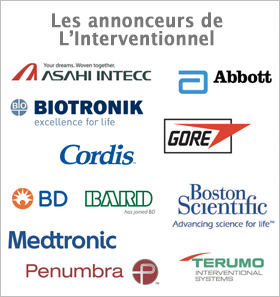European Corner
Publié le 30 mar 2025Lecture 4 min
Current algorithm about the endovascular treatment of femoropopliteal atheromatous lesions?
Yann GOUËFFIC, Hôpital Saint Joseph, Paris

Dans cette rubrique, nous donnons la parole à des experts européens. Pour cette quatrième session, rencontre avec Barend MEES et Willemien VAN DE WATER, Department of Vascular Surgery, Maastricht (Pays-Bas).
L’INTERVENTIONNEL
Algorithm for treatment of femoro-popliteal lesions? What is your favorite approach? Why? Please describe what types of devices that you use to do it. What do you think about radial approach?
Depending on the location of the lesion and the habitus of the patient, we perform either antegrade or crossover access. We always use ultrasound-guided puncture and regular brachial puncture needles. We both use preclose (suturebased) as postclose (plug-based) closure techniques. Retrograde access is performed with a low threshold in crossing chronic total occlusions, but always thinking not to burn bridges for future bypass options. For retrograde pedal or popliteal access, we use both ultrasound as well as fluoroscopy guidance and micropuncture systems. We don’t use radial approach for feasibility and safety reasons. Regarding feasibility, distance to the lesion (Dutch people are very tall on average) affects navigation and not all devices have sufficient length. In terms of safety, we consider thromboembolic cerebral events and risk of radial occlusion. Therefore, our standard access currently still is the common femoral artery.
L’INTERVENTIONNEL
Are you a subintimal or intraluminal crossing believer? What are the reasons? Could you describe your guidewire escalade to cross chronic total occlusion? How do you proceed in case of crossing failure (re-entry device? Retrograde access?)
We aim to achieve an anatomical reconstruction; if possible, we stay intraluminal when crossing CTOs, aiming to drill and finding microchannels with an 0.18 workhorse wire. As mentioned, we may approach from both an antegrade or retrograde fashion. If we end up subintimal, we have a low threshold for using a re-entry device to return to the lumen. In all cases we aim not to increase the length of the lesion by progressing in the subintimal space distal to the lesion, and especially not to burn bridges for future bypass options.
Barend recently wrote an editorial in the EJVES (with big friends Koen Deloose and Cagdas Unlu. Eur J Vasc Endovasc Surg 2024 ; 67 : 1027-30) about guidewire selection and techniques. In the below table from that paper a proposed algorithm for guidewire technique and escalation is depicted.
L’INTERVENTIONNEL
Vessel preparation. What are your techniques of vessel preparation? How do you evaluate the quality of vessel preparation? What are your thoughts about atherectomy, IVL or scoring balloons? Do you see any interest in IVUS or OCT for the SFA?
Despite all promising innovations, we stick to the available evidence and European guidelines and start with a plain old balloon angioplasty for 2 minutes, sized 1:1 to the vessel diameter. In calcified lesions in locations that we are reluctant to stent (such as the popliteal fossa or in women with gracile vasculature), we sometimes do use IVL first. We use IVUS for every deep venous case, but not to evaluate SFA angioplasty results. Note there is no health insurance reimbursement for IVL or IVUS in the Netherlands.
L’INTERVENTIONNEL
Treatment. For medium length lesion, what is your strategy between DES and DCB? For long lesions (>15cm), does it change? Do you have still any indication for bare metal stent? What is the place of self-expendable covered stents in your strategy? How do you treat re-stenosis? Any ongoing/future studies that would help clarify femoropopliteal treatment?
Length of the lesion does not affect our decision to use adjuncts. In case of an optimal angioplasty result in two directional DSA, we liberally use DCB to decrease the risk of restenosis. In case of dissection or suboptimal angioplasty result, we use regular self-expanding stents or nitinol-braided stents depending on the location of the lesion. Based on the aggregated evidence and ESVS guidelines, we do not use drug eluting stents in the SFA, but regular self-expanding stents. Covered stents are used in case of an unexpected subacute occlusion to prevent a ‘potato masher effect’ and shower thromboemboli to the foot. We treat re-stenosis usually only when symptomatic using the same algorithm: POBA for vessel prep; definite treatment with DCB or self-expanding stent. We are one of top three enrollers in the SUPERSURG RCT on CFA treatment and are eager to learn the results of this study to guide future CFA treatment. Finally, we are anticipating the start of a national RCT on strict duplex follow-up versus only clinical follow-up after endovascular revascularization for CLTI.
L’INTERVENTIONNEL
Future & perspective. What are your thoughts on Limus technologies? BASIL BEST CLI have modified your strategy in CLTI patients? Any reactions about SPORTS?
We have no experience yet with Limus technology and are not aware of superior efficacy from sirolimus-coated balloons over paclitaxel-coated balloons. One of the most striking results of BEST CLI (and BASIL) is the vulnerability and bad prognosis of CLTI patients. It once again shows that it is of imminent importance to discuss the goals of the patient and the available options to obtain those goals. All CLTI patients should be offered advanced care planning at time of diagnosis. Not to revascularise, or even not to operate at all, may also be a suitable option for your patient. Next, endovascular interventions are not ‘for free’ and not without adverse events. Lastly, if you have a good single segment vein, do not forget the option of a surgical bypass, which remains a durable and valuable option.
Attention, pour des raisons réglementaires ce site est réservé aux professionnels de santé.
pour voir la suite, inscrivez-vous gratuitement.
Si vous êtes déjà inscrit,
connectez vous :
Si vous n'êtes pas encore inscrit au site,
inscrivez-vous gratuitement :


